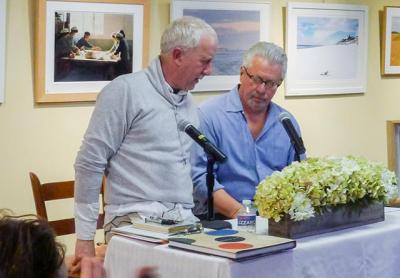Collector and Fan Probes Artist’s Work

A broad discussion about art — and the business of art — engaged a capacity audience on Saturday at the Amagansett Library when Randy Lerner, an Amagansett resident and art collector, interviewed the artist Dan Rizzie, who lives on North Haven.
In a program titled “Encryption/Description: Rizzie on His Art,” Mr. Lerner, clearly a fan and student of Mr. Rizzie’s career, probed the origins of, inspiration for, and recurring themes in the artist’s work. The discussion was the first in the third annual Art/History/Amagansett series, organized by Ellen T. White, which was followed on Sunday by “The Art of Collecting on the East End.” The series will resume this weekend and on Sept. 23 and 24.
Mr. Lerner cited Minimalist, Constructivist, and palimpsest examples in Mr. Rizzie’s painting, printmaking, and collage. “To me,” Mr. Lerner said, palimpsest “refers to when you have a surface that can receive graphic information and then remove that and put more. It deals with whether the surface has memory, with whether or not there’s a conversation you’re having with the surface.”
The medium is a fascinating one, Mr. Rizzie agreed. He collects discarded papers, including paper that children have written on and backings for photographs. “If you look through my work there’s a surface, a texture to it. I do create a situation that makes a conversation between all that stuff.”
“Work that allows you to add information is kind of what the 20th century is about,” Mr. Lerner said. “The idea, once photography arrives, of looking at art as somehow conveying information is over.” The camera conveys information about whatever it captures, he said. “If somebody is able to create something that allows you to add information and create a dialogue with what you’re looking at, it becomes interesting to live with it, it becomes interesting to see it, it becomes interesting to attach memory to it.”
Mr. Rizzie, who moved to Sag Harbor after commuting between New York and Dallas, where he went to graduate school, discovered that he had drawing talent as a child. He explained that his interest in palimpsest media, and his use of symbols, might have sprung from having grown up as the son of a diplomat in Amman, Jordan, New Delhi, and Egypt. “Living in Egypt, India, Jordan, all you see are surfaces that are papered over. There’s an Abstract Expressionist painting on every corner in India. It worked its way into my work.”
At the time, he wanted to be home in the United States, he said, but later realized the profound influence of the experience. He started painting tulips 25 or 30 years ago, but on a recent trip to India and the Taj Mahal in Agra, “I saw my work right there,” he said of the carvings and inlays of the 17th-century mausoleum. “Apparently going to the Taj at 16 stayed in my mind, and came out on paper one day.”
Mr. Lerner “has often informed me about what I’m doing,” the artist said. “I just work . . . I have this laboratory, which I refer to as a studio but it is very much a laboratory, and I’m making experiments, some successful, some not.” Mr. Lerner said Mr. Rizzie “is in a constant state of conversation and dialogue in this laboratory.”
The late artist Alan Shields, who lived on Shelter Island, had given Mr. Rizzie a buoy attached to a chain, which he hung from a tree in his yard. “That circle is going to become, in many ways, a defining characteristic in your image making from then on,” Mr. Lerner said.
Mr. Lerner described the art world in America as “a very unforgiving environment.” What is it to be an artist and sell one’s work in 2017, he asked. “I make something for myself,” Mr. Rizzie said. “It keeps me honest, doing something that I would like to have myself. . . . I try, when I make a piece of artwork, to make something that has value — not financial value, but something that has value to me.”
On Saturday at 6 p.m., the Art/History/Amagansett series continues with a screening of the documentary “Alexander Calder.” On Sunday, also at 6, Carol Steinberg, an attorney, will present “Reading the Fine Print: What Artists Should Know . . . but Are Afraid to Ask.”
